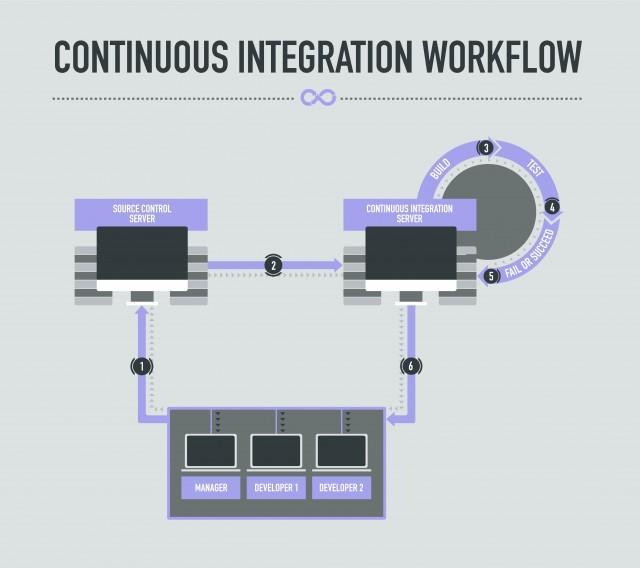How to Use Continuous Integration throughout Your Application’s Lifecycle
Not so long ago, applications were developed and deployed with on-site Application Lifecycle Management ALM solutions. More recently, the automation of processes, such as building and testing apps, has made application lifecycle management more of a way to manage application workflows. Agile methodologies have played a large role in transforming ALM culture, driving a shift toward a more holistic view of the application rather than focusing on the delivery of features, updates, and other improvements. Additionally, Continuous Integration, an Agile methodology, continues to be a valuable practice where developers integrate their work frequently. This article takes a look at the current state of Agile ALM with a focus on Continuous Integration, its techniques, and how it drives application development.
What Is Continuous Integration?
Continuous Integration, also known as Continuous Development, is a practice where developers integrate each new piece of code they create in real time. Developers typically create several new pieces of code per day, integrating each one as they go. This makes for a much more efficient development cycle that produces much higher quality code, which, in turn, leads to fast deployment cycles. By checking code in several times a day, developers can detect bugs and resolve them early, before they become major problems.
[RELATED CONTENT: Want to go agile in your company but never done it before?]
How Does Continuous Integration Work?
To get the most out of Continuous Integration, Martin Fowler says the development team must maintain a single source repository with version control. This code repository can be hosted wherever you want, but a couple of popular examples are Github and Heroku. The idea is to have a master copy of the source code that is accessible to each developer. When a developer writes new code, it is tested and debugged. After debugging, the new code is integrated into the master copy. A little later on, the developer writes more code, debugs it, then integrates it into the master codebase. Integrating small bits of code several times a day makes it much easier for the development team to find and resolve bugs in the code.
This may seem counter-intuitive from outside the development team, but by having a shared, stable codebase to work with, errors are found much more quickly and resolved. This translates to much faster development and deployment cycles when compared with traditional development practices.
Why Is Continuous Integration Faster?
When all developers on a team are sharing a single repository of code, no single developer can ever stray too far from the original codebase. When developing locally, a developer sometimes finds himself out in the weeds. With a shared master version of the source code, that developer can simply update his working version of the source code and start over. The developer loses a nominal amount of time, but the project can still keep moving forward.
This is in stark contrast to older methods where development may have continued using a hack or workaround to deal with the buggy code. This approach often resulted in technical issues dogging the product after deployment into production, sometimes with catastrophic results.
Continuous Integration also speeds up debugging. Without the frequent builds and test cycles that accompany each integration, a bug can lie undiscovered for a long time. When it finally does surface, it may take days or weeks to resolve. Continuous Integration exposes bugs a lot faster and, with frequent updates to the master source code, makes the debugging process a lot faster and easier.
How Does Continuous Integration Fit into ALM?
Continuous Integration provides an efficient means by which to integrate new features, updates, and improve performance much more quickly, driving faster deployment cycles. This translates to a high level of customer satisfaction at a fraction of the cost of traditional development methods.
What About Complex Projects?
Today’s applications are often complex, running separate modules of code that talk to each other through APIs. Continuous Integration can be applied to each module of code with tests tailored to each module. The primary difference, in this case, has to do with taking a kind of spoke-and-wheel approach, where the modules are spokes and the wheel is where they are all integrated into a single application. Testing must follow this pattern, as well — after each module is tested, all of the modules need to be run inside an integration machine that can test for issues between modules as well as build them into a single app.
[RELATED CONTENT: Quality Assurance Throughout Your Software Development Process]
The Key to Successful Continuous Integration
Strong communication between development team members is critically important; it keeps everyone on the same page throughout every step of the lifecycle of an application. This communication takes two key forms: developer training and code documentation.
Developer Training and Communication
Each developer needs to have a clear understanding of how ALM works at your organization, with a focus on Agile methodologies, continuous integration, development cycles, and deployment cycles. This helps minimize confusion and the critical errors that often follow.
Next, each developer needs to know which development environment he or she will be using, how to use all of the tools in it, and when to use them. In a DZone article, Eva Johnson called the Integrated Development Environment a “Golden Opportunity”. She explains that, to get the most out of Continuous Integration, the same development environment and tools need to be used by everyone on the team. This can be a virtual machine with a box that is configured for a specific project, or a container that provides the same development environment and tools for all developers on a team. This saves a lot of time and frustration debugging errors in a development environment a developer has set up on his own. Something as minor as a different version of the operating system or version of VirtualBox can derail a development environment’s preparation by a few hours to a full day. In the end, having a pre-configured development environment for your developers makes everyone happier.
Code Documentation
Documenting code is the process of writing brief, precise descriptions of what a block of code does. Clearly written documentation guidelines are crucial to ensure that developers consistently describe what each block of code does. Poor documentation leads to confusion and a lot of wasted time trying to figure out what a particular block of code does when something goes wrong. Well commented code with proper documentation makes the code’s functionality transparent to anyone reading the documentation. Keep in mind that we are not advocating for complex, strictly regimented code documentation as we like to adhere to the Agile principle of communication and iteration over excessive documentation. However, it is crucial to have an overview of the purpose, tools, language, and other information that is accessible to everyone on the team.
Conclusion
Continuous Integration is the core process that makes Agile ALM work. Its methodology results in fast development and deployment cycles with high-quality results. When combined with thorough developer training, a consistent development environment, and automation, continuous integration turbocharges the application development cycle. This creates an Agile ALM that is fast, efficient, and capable of consistently producing high-quality enterprise applications.
More on Perficient Latin America: With more than 30 years of experience and a robust portfolio of international clients, Perficient Latin America specializes in outsourcing and nearshoring software development projects as well as Team Augmentation. Based in Colombia, Mexico, and the US, Perficient Latin America is an agile SCRUM development shop focused on high-quality services.




